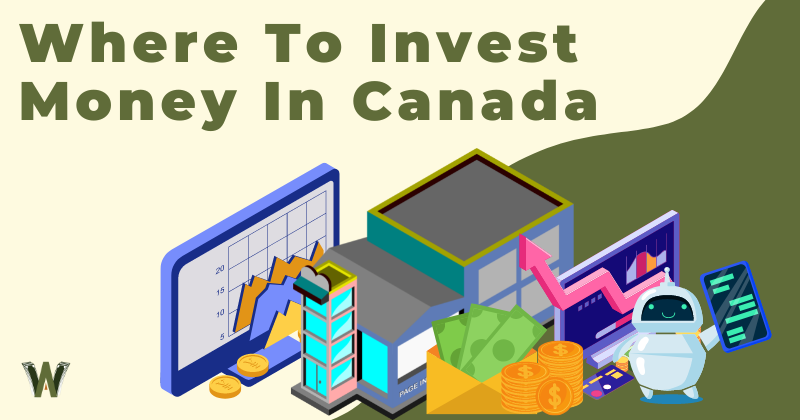Do you have extra money that you are looking to invest but do not know what some of your best options are?
While just under $2.1 trillion in assets across both mutual funds and ETFs in Canada at the end of October 2022, your investment choices are not just limited to funds when it comes to growing your money.
Investing in different assets can come with drastically different things to consider.
I will cover where to invest money in Canada below and go over the key characteristics of each different asset.
Key Considerations Prior to Investing
Before deciding on where and what to invest your money in, you need to assess your personal situation and what you are looking to get out of your investment.
Here are some key things to consider before investing in anything.
- Ask yourself why you are investing and what your goals are.
- Determine what your investment time horizon is.
- Think about your ability to take on risks – how important is this money to you?
- Consider your willingness to take on risks – how emotionally comfortable are you with taking risks?
- Are there any chances that you may need to redeem your money early?
- Think about how often you plan to check on your investments.
- What type of returns are you aiming for?
- What other investments do you currently hold?
- How much time do you plan to spend managing your investments?
- Do you need income from your investment?
It is important to have a plan outlining your investments, goals, and your personal situation.
Where to Invest Money in Canada: Six Different Investment Options
1. Stocks

- Riskiness: medium – high
- Minimum amount to invest: low – high
- Fees: low
- Time commitment needed: high
- Investment horizon required: medium – long
- Liquidity: medium – high
- Income: none – high
Stocks are one of the most common asset classes that come up when discussing investing. Stocks allow an investor to buy a tiny ownership share in a publicly-traded company.
Since investors can invest in virtually any type of publicly-traded company, stocks have varying risks. Even the least-risky stock, however, comes with a medium risk because an investor’s ownership in a company comes after lenders and creditors.
Minimum investment amounts vary among stocks – some shares trade for several shares while some shares can trade for several thousands of dollars.
Fees involved with investing in stocks mainly come from trading commissions since stocks do not charge investors any fees directly. These trading commissions tend to be low relative to other investments.
Investing in stocks requires a significant time commitment (in the form of researching and managing the portfolio over time), and the time horizon for returns is usually at least several years.
Stocks can vary in liquidity and can also pay very high income (through dividends) or no income at all.
- Make sure to check out my list of the best stocks in Canada.
2. Bonds

- Riskiness: low – high
- Minimum amount to invest: high
- Fees: medium
- Time commitment needed: high
- Investment horizon required: short – long
- Liquidity: low
- Income: low – high
Lower on the risk spectrum relative to stocks as an investment are bonds. Bonds are essentially loans to a counterparty, which can include governments, companies, or even individuals.
Depending on who a bond issuer is, a bond can come with lower risk (i.e. government issuer) or higher risk (i.e. distressed company issuer). Relative to stocks, bonds are generally safer because bondholders get paid before stockholders in the event of bankruptcy.
Bonds usually come with high minimum purchase amounts, making it difficult to diversify a portfolio of bonds with little capital. Bonds will also have to be closely researched, requiring a substantial time commitment.
Since bonds trade over-the-counter (OTC) and not on an exchange (like stocks), trading commissions and spreads can be quite substantial.
Depending on when a bond’s maturity is (and if you want to hold the bond to maturity), the investment timeframe for a bond can be a few years or a few decades.
Since bonds are not traded through an exchange, they usually have limited liquidity, although they can be sold before maturity. A bond’s income level will depend on the riskiness of the bond – safer bonds will pay less while riskier bonds will pay a higher level of income.
3. Exchange-Traded Funds (ETFs)

- Riskiness: low – high
- Minimum amount to invest: low
- Fees: low – medium
- Time commitment needed: low – medium
- Investment horizon required: short – long
- Liquidity: medium – high
- Income: low – high
Exchange-traded funds are a type of fund (pooled investment) that allows you to access a basket of investments through one solution. ETFs can track a wide range of investments, including stocks, bonds, alternatives, and more.
The underlying investment within the ETF will determine how risky the ETF is as a whole. A stock ETF will be a riskier investment (usually) than a bond ETF.
ETFs usually come with little minimum purchase requirements – you either have to buy one ETF unit, or you can even buy fractional units in some cases.
Exchange-traded funds generally come with low fees, especially relative to mutual funds. Actively managed ETFs usually come with higher fees than passive ETFs. ETFs usually require less of a time commitment than bonds or stocks because they pool multiple investments in one fund.
The investment time frame of an ETF will again depend on the underlying assets within the fund. ETFs are typically designed to be held for the long term (bond ETFs do not have a maturity date).
An ETF’s liquidity will depend on how large it is and how frequently it is traded. A newer ETF will have relatively less liquidity. Some ETFs pay no income, while other ETFs pay very high-income streams – it all depends on the underlying investments.
- Be sure to take a look at my list of the best ETFs in Canada.
4. Cash Equivalents – GICs and High-Interest Savings Accounts

- Riskiness: low
- Minimum amount to invest: low
- Fees: none
- Time commitment needed: low
- Investment horizon required: short – long
- Liquidity: low – high
- Income: medium – high
Cash equivalents such as GICs and high-interest savings accounts are excellent investment choices if you are a very risk-averse investor. Consider GICs if you are willing to lock up your capital for a specific amount of time or a high-interest savings account if you need constant liquidity.
Cash equivalents are usually considered low or very low-risk investments. Since they are low-risk, they tend to offer low returns that are usually closely tied to the level of interest rates in the economy.
GICs and high-interest savings accounts usually have low deposit minimums. They are also typically offered on a fee-free basis.
Cash equivalents usually do not require a large time commitment. GICs can have varying maturities depending on your time horizon, which is also directly tied to their liquidity. High-interest savings accounts typically do not have any liquidity constraints.
Both GICs and high-interest savings accounts should be paying a decent level of income which is closely tied to the current level of interest rates.
5. Direct Real Estate

- Riskiness: medium – high
- Minimum amount to invest: high
- Fees: medium
- Time commitment needed: high
- Investment horizon required: medium – long
- Liquidity: low
- Income: medium – high
Direct real estate – the purchasing of physical investment properties, is a very popular investment option for a large portion of investors. Real estate is something tangible that you can own, and you become responsible for generating returns from your properties, either through rent or by flipping them.
Real estate carries a medium-to-high risk, with risk increasing substantially as a real estate market enters a bubble or interest rates begin to rise (making mortgages harder to sustain).
Purchasing properties usually comes with a high minimum investment and can have substantial fees (mainly from real estate agents) and closing costs.
Investors usually have to invest a considerable amount of time researching properties and managing tenants. Investment properties are also usually purchased for the long term or, in rare cases, for short-term flipping purposes.
Physical real estate is usually a very illiquid asset – properties can be tedious and time-consuming to sell.
Real estate generally offers a good level of income in the form of rent. The collection and management of tenants become the investor’s responsibility unless they decide to use property management services.
- Check out my guide on the best real estate investing options.
6. Robo-Advisor

- Riskiness: low – high
- Minimum amount to invest: low
- Fees: low
- Time commitment needed: low
- Investment horizon required: medium – long
- Liquidity: high
- Income: low – high
Robo-advising is less of an investment and more of an approach to investing. A robo-advisor is designed to build an investment portfolio for a client (using stocks, bonds, and funds) at substantially lower fees than a human advisor.
It is a service that is offered by many brokerages in North America and around the world.
A robo-advisor will present investors with questionnaires in order to determine an appropriate level of risk and match investors with an appropriately-risky portfolio.
Robo-advisors typically come with low fees and have low minimum investment requirements.
The time commitment for using a robo-advisor is fairly low and mainly requires completing the account setup as well as the questionnaires for determining your portfolio.
Based on your responses to the setup questionnaire, the robo-advisor will construct a portfolio with a long-term horizon or a short-term horizon. This also applies to your personal liquidity requirements.
Lastly, the robo-advisor should also be able to create income-generating portfolios if this is something outlined in the early questionnaires.
Excellent robo-advisor options in Canada include Questwealth and Wealthsimple Invest.
Frequently Asked Questions
What are Safe Investments with High Returns in Canada?
Unfortunately, safe investments do not typically come with high returns. High investment returns are usually reserved for investors that are willing to take on excess risk.
Safe investments, such as cash equivalents, typically pay more conservative rates of return that are closely tied to interest rate levels.
Investing Money in Canada for Beginners?
If you are new to investing, putting your money to work can seem daunting. Be sure to take a look at my investing for beginners in Canada guide for a detailed breakdown of how to get started.
Conclusion

If you have money that you are looking to invest and grow here in Canada, you have an abundance of options to choose from. Although I have not covered every single possible investment option, the investment choices outlined above are the most popular and are appropriate for the large majority of Canadian investors.
If you do not have any time at all to plan or worry about your investments, working with a human investment or financial advisor is also an option. I do not recommend this option as it generally comes with very high fees relative to other alternatives (such as robo-advising).
If you have decided to take a more hands-on approach to investing, make sure to read my guide on how to buy stocks in Canada, as well as how to buy ETFs in Canada. These guides can help you to avoid making numerous rookie mistakes early on in your investment journey.
